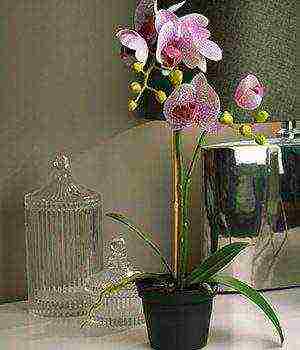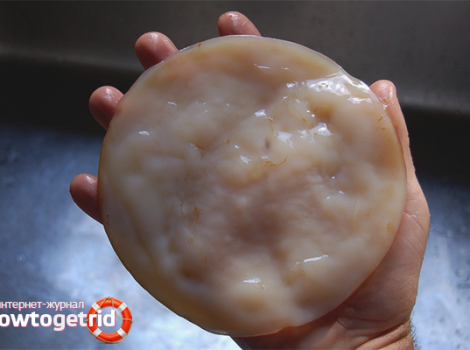Content
- 1 Coleus description
- 2 How to sow garden coleus seedlings
- 3 Planting Coleus in the ground
- 4 Caring for Coleus in the garden
- 5 Growing indoor coleus from seeds
- 6 How to grow Coleus from a cutting
- 7 Caring for Coleus at home
- 8 Problems in the care, diseases and pests of the coleus plant
- 9 Coleus wintering
- 10 Types and varieties of coleus with photos and names
- 11 The best varieties of coleus popular with us:
The Coleus flower belongs to the genus of the Lamiaceae family (they are also Lipocytes), there are more than 150 species. The name of the plant is derived from the Greek "kleos" - case. The tropics of Africa and Asia are considered the homeland of Coleus.
Amateur flower growers also call Coleus "poor man's croton", because its variegated color of leaves is similar to the foliage of this plant, but looks a little simpler. However, new varieties of Coleus are able to compete not only with Croton, but also with many popular expensive flowers. In addition to variegated foliage, Coleus has an excellent advantage - it is easy to clean.
Coleus description
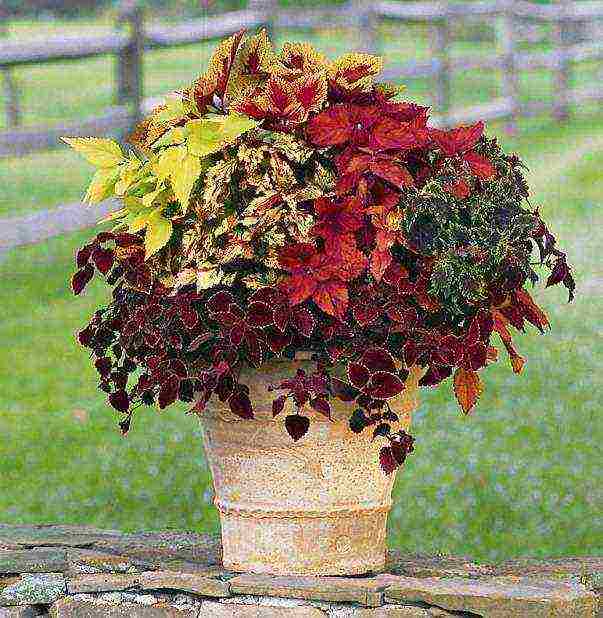
How to grow Coleus in the garden and at home photo
Coleus has a ribbed, tetrahedral stem, woody at the base. Leaves are heart-shaped, pubescent, toothed, opposite, can be small, and in some types of foliage reaches a length of about 15 cm.
- Coleus is popularly called nettle, because its leaves, stems are similar in shape and structure to nettles.
- The color of the foliage of the Coleus is varied - various combinations of green with a burgundy, yellow, red tint. The flowering of Coleus is unremarkable and does not cause much interest: small flowers of a blue or purple hue are collected in a spike-shaped inflorescence.
- The peduncle can be cut off so that the plant does not lose its decorative effect.
- Most species of Coleus are grown for the sake of the amazing beauty of the leaves, but there are species and varieties of Coleus with quite interesting flowering.
How to sow garden coleus seedlings
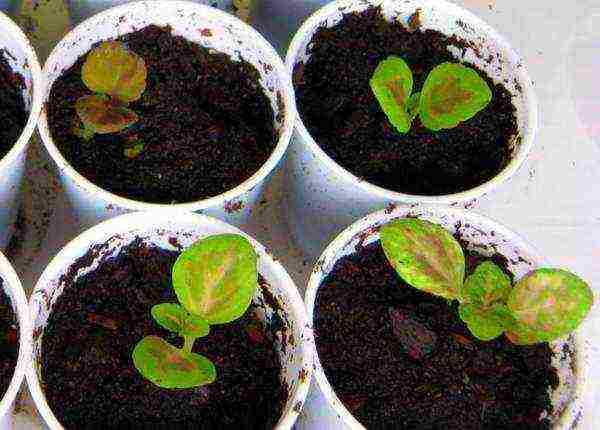
Garden Coleus from seeds photo of seedlings
Coleus is popular for its variegated foliage and ease of care. The main thing is that it can be grown both indoors and in gardens. It reproduces perfectly by the seed method; various seeds of interesting English, Dutch and many other varieties are available in flower shops.
- Sow seeds in late March in flat boxes.
- You can sow for the winter, but you will have to create artificial lighting in the fall and winter.
- Choose a fertile, light soil.
- It is best to use a flat sowing container.
- Individually, not in piles, spread the Coleus seeds on the soil surface, spray from a spray bottle, do not deepen the seeds, but lightly sprinkle with sand, as if salt.
- Build a greenhouse, covered with glass or film, place the container with crops in a warm, dark place. Maintain soil moisture.
Purchased seeds germinate well, literally every seed can germinate. The seeds will sprout quickly - in a week, a maximum of 10 days. When the first shoots appear, the shelter must be removed and the greenhouse must be moved to a lighted place, preferably to the western or eastern window. Protect delicate seedlings from direct sunlight. Maintain a temperature range of 17-19 ºC.
Upon reaching the age of 3-4 weeks and with the appearance of the first pair of true leaves, transplant the Coleus into separate cassettes so that a strong root system can develop that can withstand the subsequent transplant into the ground.Young plants at the age of 5-6 weeks are transferred into spacious cups and pinched to stimulate branching.
How to grow Coleus, we look at the video:
Planting Coleus in the ground
Plant the Coleus in open ground with real warmth. Choose a location that is brightly lit, but slightly shaded during midday hours, and the area should be sheltered from the wind. Prepare the holes, fill them with fertile air and permeable soil, plant the coleus from the cups into the holes.
Planting a coleus does not require special knowledge and skills, especially if it is grown as an annual. Growing like a perennial is unlikely to succeed, because after a couple of years the bushes will degenerate, and for the winter, the Coleus will need to be dug up and brought into the room in order to plant it in the ground again in the spring.
Caring for Coleus in the garden

Coleus in landscape design photo
- First and foremost, you need to water regularly, especially in dry summer weather.
- Water preferably with settled water. You can install a tub or barrel in the garden to settle tap water in it and accumulate rainwater.
- After watering, loosen the soil, remove weeds.
- To make the Coleus bush harder, you can pinch the tops of the motley handsome a couple of times over the summer.
During the period of active growth, apply top dressing with a high nitrogen content every 10-12 days. This will promote active foliage growth and delay early flowering. Peduncles must be removed immediately, because they take away strength from the nettles.
Growing indoor coleus from seeds

Coleus from seeds at home photo
Indoor coleus, just like garden coleus, propagates by seed and vegetative method. Seed reproduction occurs in the same way:
- Sow seeds in a wide, shallow container with drainage holes in the bottom to a depth of 0.5-1 cm as rarely as possible. It can be scattered over the surface and lightly sprinkled with earth.
- Spray from a spray bottle, cover with a transparent lid, glass or bag, ventilate daily, water through a drip tray or from a spray bottle.
- With the emergence of shoots, remove the shelter.
- Maintains moderate humidity and good lighting.
- Dive the seedlings at the stage of 2-3 true leaves into separate cups, and after growing, plant them in permanent pots by transshipment.
How to grow Coleus from a cutting
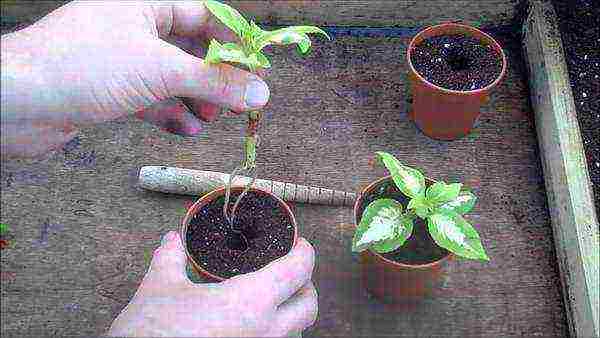
Coleus cuttings photo
- The cuttings are cut into small ones, about 10-12 cm.
- Remove the leaves from the bottom, stick the cutting into damp soil or sand, cover with plastic wrap or a cap from a cut plastic bottle, place in the shade and keep the temperature at 18-20ºC.
- After 8-10 days, the roots will appear, and when the first shoots appear, you can transplant the seedling into a permanent pot.
- You can root it simply in water, and when roots appear, plant it in pots.
This type of propagation is simple and reliable, it allows you to quickly get strong new plants.
Caring for Coleus at home

How to care for Coleus in a pot photo
Watering and feeding
Water with plenty of room temperature softened water. Spring and summer are the most important times in maintaining watering. During this period, you also need to fertilize weekly. Apply mineral fertilizers in half the doses recommended by the instructions. In winter, it is enough to feed once a month.
Air humidity
In the warm season, spray Coleus regularly, but do not do it in direct sunlight, but take the plant into the shade. The best way to maintain air humidity in the winter is to periodically place the flower pot on a pallet of damp expanded clay. If the coleus is not decorative flowering, the spike with flowers must be removed.
Pinching and trimming
During active growth, Coleus must be constantly pinched to stimulate branching. After winter dormancy, in order to renew the plant, you need to cut off all the shoots at a height of 5-7 cm.The shoots obtained during pruning can be used as cuttings, because there is a risk that last year's flower will not justify your efforts and will lose its decorative appearance.
How to form a coleus bush, the video will tell:
Problems in the care, diseases and pests of the coleus plant
Important points:
- if you do not pinch and cut off the coleus in time, the shoots will noticeably stretch out. The same situation will develop when there is a lack of light or when the plant gets old.
- very bright lighting will lead to faded, discolored foliage.
- with a lack of moisture, as well as with waterlogging, the result is the same: the foliage will begin to fall off. Pay attention to what you are doing wrong.
Coleus can be damaged by spider mites, aphids and whiteflies. Yellowed and shriveled leaves will indicate the appearance of aphids - you can treat the ground part of the plant with soapy water, do not forget to cover the soil so that the soap does not get there. You can repeat the procedure after a week. For garden coleus, this procedure can be problematic, so it is better to treat with insecticides. Soap solution will not help with other pests - also use insecticides. The use of chemicals will not add to the health of the plant, so provide proper care and no disease, and pests will not disturb the flower.
Coleus wintering
Garden Coleus is grown as an annual. But, in order not to lose the plant, it can be dug up and brought into the house, caring like an indoor flower. By winter, you need to gradually reduce watering, apply fertilizing once a month. Maintain the air temperature between 8-15 ºC.
Types and varieties of coleus with photos and names
Coleus hybrid Coleus x hybridus

Coleus hybrid Coleus x hybridus ‘Japanese_Giant’ photo
Most commonly grown as a houseplant. This species is completely unpretentious. The stem is square, reaching a height of up to one meter. Leaves are oblong-oval, serrate edges. Depending on the lighting, the color of the leaves changes: in the shading it is green, and under the sun it is burgundy.
There are a great many varieties of hybrid forms, it is impossible to describe all the variety of shapes and colors, and each creation of breeders is distinguished not only by beauty, but also by resistance to disease, excellent vitality and survival in any conditions.
Coleus rehneltianus
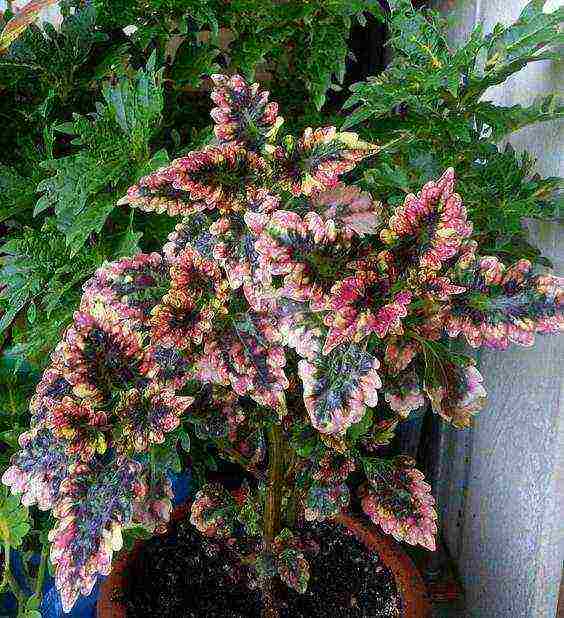
Coleus Renelta Coleus rehneltianus photo
Originally from Sri Lanka. It is grown as a decorative ampelous plant. Reaches a height of about half a meter. The leaves are wide, heart-shaped with a wavy edge, attached on long petioles, arranged oppositely. The foliage is decorated with veins of different colors - yellow, purple, brown, red.
Coleus blumeii Coleus blumeii
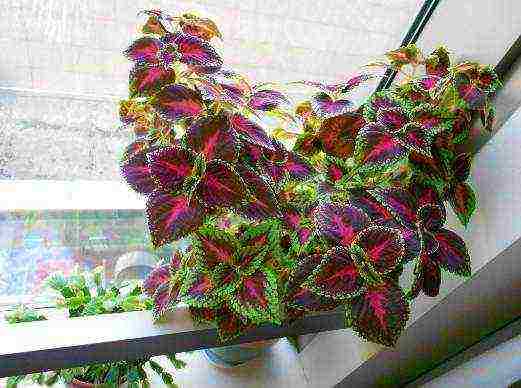
Coleus Blume Coleus blumeii photo
It is most popular with florists. A native of Southeast Asia. This is a semi-shrub, reaching a height of about 80 cm. The shoots become lignified over time.
The best varieties of coleus popular with us:
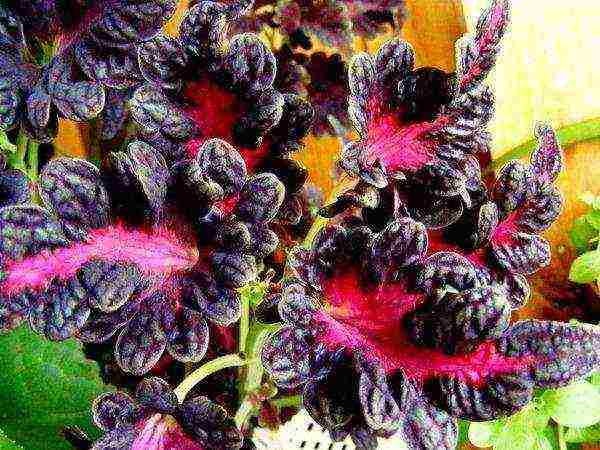
Coleus bloome Black dragon Dragon Black photo
Black dragon: has corrugated brown-purple leaves with red veins on the edges;
Series Wizard:
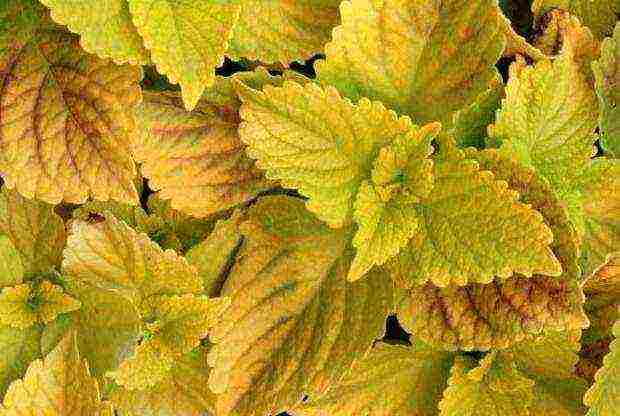
Coleus golden wizard Wizard Golden photo
Golden Wizard - has yellowish satin leaves;
Wizard Evening Zarya - fiery red foliage with a greenish border;
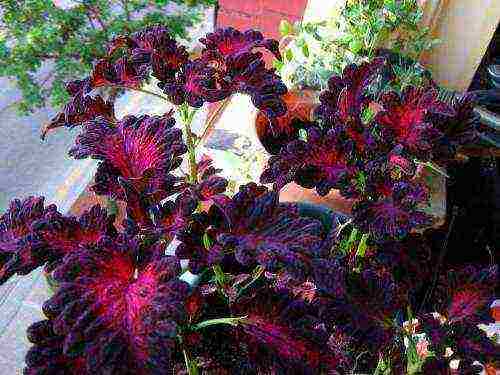
Coleus variety coral dawn Black Dragon Wizard Coral Sunrise photo
Wizard Jade - white foliage with a wide green border.

Coleus Wizzard Jade photo
A wide variety of species and varieties will allow you to decorate your home all year round, and your garden in warm weather.
An elegant and colorful pet with variegated leaves has long attracted florists around the world. Its unpretentiousness and undemandingness to the conditions of detention allows even novice gardeners to grow it. This native of the Yasnotkovye family means "case" in Greek. But it came from the humid tropics of Africa.
Content:
- Growing and care
- Location, lighting and temperature
- Watering and moisturizing
- Soil and fertilizers
- Choosing a pot and pruning a plant
- Coleus pests and diseases
- Spider mite, aphid, scale insect
- Loss of decorativeness
- Reproduction and transplantation
- Cuttings
- Seeds
- Flower transplant
- How to choose a healthy plant in the store
- Types and varieties
Coleus are very fond of the sun and they are not at all afraid of direct sunlight, they also love humidity, moderate watering and frequent spraying - the key to successful flower care.
Its leaves are oval in shape, the surface to the touch is similar to velvet. They represent the greatest decorativeness and can be of various colors: purple, red, yellow, pink. Most of the species are variegated, with many patterns, patterns and shades. Monochromatic green mass is a rarity.
Growing and care
Location, lighting and temperature
Pet loves to enjoy the direct rays of the sun... Lack of light is destructive for him and leads to dropping of foliage, stretching, and deformation of shoots. But an excess of ultraviolet radiation is not required. From him, extraordinary patterns on the leaves disappear. Also, excessive lighting slows down or stops growth altogether. Window sills on the east and west sides are ideal. The uniform growth of foliage is facilitated by the systematic rotation of the pot around its axis. In the summertime, you can carry it to the glazed balcony. There is enough oxygen and light for him.
Variegated and monochromatic colors require different conditions of detention. Monochromatic foliage does not need light so much and is quite content with diffused lighting.
This tropical inhabitant does not tolerate a dry microclimate. For full growth and development, spraying, a pallet with wet moss or expanded clay is necessary. With the beginning of the heating season, the pot is removed away from the heating appliances. It is permissible to install an electric humidifier in the same room as it. You can spray only with purified warm water... The dust that appears on the leaves is removed with a damp microfiber cloth.
Optimum indicators in summer + 24-26, in winter + 11-12 degrees.
Watering and moisturizing
There is no definite schedule. Coleus "sends" signals through the soil. Its upper layer should dry out slightly to the next "drink". Humidification does not differ at different times of the year. It is not worth allowing the earth to completely dry out. Stagnation of moisture is also prohibited. All the remaining liquid, which is glass in the pan, is drained. Watering with exclusively purified water at room temperature is allowed.
Dry air is the enemy of the bright representative of the flora. High indoor humidity is the key to regular and lush flowering... It can be maintained by spraying. The optimal indicators to strive for are 75-85%. When using a pallet with expanded clay, it is important to ensure that there is no contact between the soil and water. This quickly leads to irreversible processes.
Soil and fertilizers
Due to its rapid growth, preference is given to fertile, light, with good water and oxygen permeability. Acidity is neutral or weak. It is prepared independently from:
- compost (2 parts);
- peat;
- sand in equal parts (1 share each).
The store sells a clay soil mixture or substrate without soil. And although the pet is not capricious in this regard, it is the sufficient amount of contained trace elements and nutrients that determines its further development. Needs nitrogen. Therefore, it is regularly introduced as a top dressing.
With the coming of spring mineral complexes revive the color of the foliage, and activate the growth of the coleus. After wintering, this is the first necessity. From June to August, there is a regular introduction of nutrients: potassium, nitrogen, complexes for indoor plants. It is more convenient to add them in liquid form, diluted with water. A handful of ash is added to the liquid.After transplanting or in the case of buying a new plant, feeding is not required 3-4 weeks.
Choosing a pot and pruning a plant
A spacious one is required, at least 18 cm deep. There are always through drainage holes at the bottom. A wide base will allow the vessel to become more stable and avoid further overturning. It is not worth planting in a huge container right away. This is fraught with rotting of the root system. But with each transplant, the flowerpot is chosen much more than the previous one. Fast growth allows you to fill it in a short time. The material is preferably lightweight. In a plastic container, it is easier to carry and put in another place.
Trimming is a must-have item in the list of wheel requirements. It runs from March to April. During this period, the appearance changes dramatically. Shoots are cut by two-thirds. In the future, the cut stems are used for cultivation. Another desirable, but not required, molding occurs during the growing season. It is not as categorical as the main one, and involves only a slight cutting off of excess processes.
A young specimen is certainly pinched.
Coleus pests and diseases Spider mites, aphids, scale insects
Spider mite
These uninvited guests do not go unnoticed for a long time: yellowing and curling leaves, the appearance of spots, stripes and cobwebs become more noticeable every day. If colonies of insects are found during inspection, measures are immediately taken. They can quickly infect other plants in the room as well.
With a small number of pests, the ground part is treated with soapy water, and after a week the procedure is repeated. But in critical cases, only chemical agents help - insecticides.
Loss of decorativeness
If the tips of the leaves turn yellow, and they themselves curl, then it is necessary to increase the humidity. Shedding foliage can indicate (if diseases and pests are excluded) a lack of nutrients. Having restored the right conditions for the care of the plant, its external attractiveness and healthy appearance will return.
Reproduction and transplantation
Cuttings
Held in the middle of winter. Delenka is selected without buds and flowers, at least with a couple of leaves. Root it in water. The moisture is periodically changed to fresh, warm. The vessel is in a damp, light room. The first roots are formed after 1.5 months. From this point on, you can transplant into a pot.
Immersion in the soil occurs down to the lower leaves.
Seeds
This method is used if there is nowhere to take the scion. Due to its good germination, cultivation in this way is used very often. With an increase in daylight hours in early spring, you can start sowing. It is permissible to do this earlier, subject to additional lighting by devices. On loose fertile soil, seeds are evenly applied without deepening them.
Sprinkle on top with a thin layer of sand. After spraying them and covering with a film, the vessel is removed to a warm, but dark room. The cap is periodically removed and ventilated. The first shoots appear in a week. From that moment on, they need a lot of sunlight. The airing time is increased daily, allowing the seedlings to get used to the microclimate.
After 1.5 months with the appearance of leaves, they are ready for diving and pinching.
Flower transplant
Frequent replanting negatively affects the already weak root system. For young specimens, it is held every spring, after molding. For an adult Coleus, it is enough to replace the top layer of the earth, if the capacity is not yet small. Taking it out of the flowerpot take extra care. The earthen lump is gently shaken off and transferred to a new "place of residence".
The first layer in it is drainage (broken brick, sand, expanded clay, perlite, pebbles, etc.).
The second is a part of a suitable substrate, on which the plant is installed. The process ends with watering and feeding.
How to choose a healthy plant in the store
The best time to buy is early spring.If the exotic is healthy, then it will have powerful shoots that grow from the root system. Do not give preference to seedlings with a small number of stems, which are preparing for flowering. This is indicative of the depletion that has developed due to the large amount of fertilization. A small number of stems is a sign of poor root development. Entrepreneurs use these tricks to boost sales.
After being transported home, it is transplanted into a spacious container. This is followed by a month of adaptation.
Types and varieties
To date, more than a hundred representatives are known. The most famous and most decorative ones are:
- hybrid (grade "Brilliant");
- Bloom ("Butterfly");
- Renelta (Yulka).
For flower lovers, Coleus is better known as nettles. It is grown not only as a garden ornamental plant, but also as an indoor plant. Thanks to its unusual bright foliage, Coleus will decorate any garden area. It can grow both in a flowerbed, together with other flowers, and as separate "islands", for example, on a lawn.
Description of Coleus
Coleus is a herbaceous plant, reaching a height of 30-50 cm. Its homeland is Africa and Asia. Ornamental foliage is a special attraction. The leaves of Coleus are pointed-ovate, of different colors and shades. Moreover, these are not only widespread yellow-white, green and lilac tones, but also purple, crimson, brown and pink. Most of the leaves, in addition to a bright color, also have decorative ornaments - spots, stripes, edging along the edge. There are about 60 species of Coleus in the wild.
Growing Coleus from seeds at home
At home, Coleus can be grown both with seeds and by cuttings. The second method is not particularly difficult. In adult plants, the tops with several leaves are cut off. Shoots are placed in a glass of water or dripped with a wet mixture of sand and sphagnum. After about 7-10 days, the cuttings will have roots, which means they can be planted in the ground.
In addition, the more often you pinch the tops of the Coleus, the more bushy it will be.
Sowing Coleus seeds for seedlings
Since Coleus is a light and heat-loving plant, it is recommended to sow seeds for seedlings at home in early spring, when the days are getting longer.
The first step is to prepare containers for sowing. These can be small containers, seedling boxes, or other containers. Moreover, they must all have drainage holes. The containers are filled with a substrate consisting of sand, a mixture of humus, peat, and crushed sphagnum. The soil is not compacted, while from the substrate to the edge of the container, approximately 2 cm should remain free.
After that, you need to proceed to sowing seeds at home. Since they are very small, the seeds are not embedded in the ground, but carefully placed on top of it, very carefully moistened with a spray bottle. The container is covered with glass or foil, transferred to the windowsill. The air temperature must be + 22 ° C.
The container is opened and ventilated for a few minutes every day. If the soil is dry, it must be moistened, but this should be done very carefully so that the seeds do not burrow into the soil.
In about 15 days, the first shoots of Coleus will appear at home. From this time on, the film is removed from the container.
How to care for Coleus seedlings?
At first, the leaves of Coleus, regardless of the variety, are green, but as they grow, they acquire their main color. When the tops of the seedlings begin to close, thereby interfering with each other, it is necessary to start picking. The sprouts are carefully thinned out, seated in separate containers. When diving, it is recommended to use a special plastic or wooden spatula, this will protect even weak roots and stems from damage.It is better to transplant sprouts with a part of the soil - this way they will take root better.
Do not forget about feeding. During this period, you can use dry mineral fertilizers. Before applying top dressing, the soil in the containers must be spilled with water.
Already after 2 months, Coleus seedlings will grow by about 15 cm, will have several real leaves, colored to match the selected variety. In this state, the sprouts can be transplanted to a permanent place. If they are intended for growing as a houseplant, then they should be transplanted into decorative pots. If the seedlings were grown to decorate the flower beds, the seedlings are transferred to the open ground only under the condition that stable warm weather has been established.
Growing Coleus in the open field
The area for growing Coleus should be well lit, but protected from wind and drafts. Direct sunlight is not desirable as it can discolor the leaves. If the site is in the shade, then the plant will be thin and long and thus lose its beauty.
The site is dug up, loosened, if necessary, sand, peat, humus are added to the soil. Seedlings are rolled along with a lump of earth into prepared holes, sprinkled with soil, watered with water. The distance between the bushes is approximately 25-30 cm.
Throughout the season, it is recommended to water the plant abundantly, feed it every week: in June - with nitrogen fertilizers, and starting from July - with complex mineral fertilizers and ash, which will give the leaves a bright color.
In order for the crown of Coleus to be lush, it is necessary to pinch and trim the shoots.
An incredibly attractive plant is coleus. Planting and care in the open field, as well as cultivation are the subject of our conversation. After all, the beauty of its foliage is not inferior to the buds, inflorescences of bright garden flowers and is always in the focus of attention, attracts eyes. If you find a competent approach to it, provide it with everything you need, it will become a magnificent decoration of your site!
Coleus flower, how and where does it grow?
This decorative deciduous shrub from the labiate family boasts an incredible palette of colors, a bizarre pattern on the leaves, and a contrasting combination of shades.
Coleus, photo:

On plots in open ground, large-leaved forms are most often planted. They quickly gain growth, turn into fluffy bushes. Coleus has a very "convenient" feature for the gardener - cuttings from it can be taken at any time.
Thus, you can multiply it whenever you want, this process is simple, almost always brings positive results.
One of the most common types of this representative is Coleus Bluma (or Blume). It is also known as the potted, indoor version, which is popularly called "indoor nettle". In any case, he is able to decorate any room, as well as complement, emphasize with his presence other flower representatives in the flower bed. However, it should be borne in mind that with the arrival of cold weather it is better to move it indoors.
The plant itself is native to Africa and the Asian tropics. Its foliage, indeed, can have a variety of color combinations and shades: bright green, copper, red, lilac, maroon, yellow, white, variegated multicolor. The shape of the leaf is actually somewhat reminiscent of a nettle leaf, and the flowers are similar in shape to spikelets, they are most often bluish or purple in color. However, Coleus is grown exclusively because of its attractive foliage, which can be serrated, hairy, and have the shape of a heart. In nature, there are about 150 varieties, and hybrid and polyhybrid varieties are especially popular.
In a pot on the street, photo:

Coleus Bluma - he is, as it were, one of the ancestors of hybrid species.It can reach a meter in height, and the foliage can change its color depending on the place of growth, the degree of its illumination by the sun's rays.


 Blum variety
Blum variety
Another famous representative, originally from Sri Lanka, Coleus Renelta, has an ampelous shape, with drooping stems and foliage. Gives color mainly in winter, blooms with small blue flowers that form a "spikelet". Most of the highly decorative ampelous cultivars were obtained from it.
 Ampel view of Renelt
Ampel view of Renelt
Before planting coleus in your area, pay special attention to the place where you want to plant it. He loves the sun, a well-lit area, where he can fully manifest all his beauty, amaze you with bright shades of leaves. Here, too, there are some little tricks: if you are going to plant a variety with red, burgundy or white foliage, then direct sunlight is exactly what you need for these varieties. But those representatives whose leaves differ in all shades of green love light shading! Green varieties (let's call them that), should be planted only in partial shade, direct sunlight can simply burn their foliage.
Coleus Black Dragon and Cherry in chocolate, photo:
 Variety Black Dragon
Variety Black Dragon Coleus Chocolate Covered Cherry
Coleus Chocolate Covered Cherry
Attention should also be paid to the composition of the soil, in principle, it can be anything, as long as it is nutritious and saturated with nitrogenous fertilizing. By the way, it is nitrogen that affects the brightness of the pattern on the foliage, contributes to the saturation of colors.
↑ to the content ↑ Coleus, methods of reproduction and planting features
It is propagated mainly by two methods - seed and cuttings. Both of these techniques are not difficult, even for beginner gardeners. As mentioned above, there are a great many varieties - the colors of the foliage can satisfy every taste. Nevertheless, breeders continue to develop new varieties to our delight.
In the respective flower shops you can buy ready-made seedlings as well as seeds or seed mixtures of all kinds. Any hybrid Coleus will feel equally good both indoors and as an element of landscape design outdoors. The flowers are not of particular decorative value, but the foliage, in addition to its attractiveness, may even have a pleasant aroma (in some species).
Planting in open ground is carried out with the arrival of a full-fledged warm spring or summer. In addition to acceptable lighting (do not forget about the color of the leaves and individual requirements), you should know that he does not like drafts. Planting sites should be located at a short distance from each other, but with such intentions that the flowers do not interfere with each other's growth and development ("fluff"). It is best to fill the dug holes with an appropriate soil mixture (fertile).
After planting, the flower should be watered (but not poured abundantly with water) and artificial shading should be created so that it adapts in the air, and the leaves do not burn out under the bright rays of the spring sun. Remember that too obvious a shadow will not allow the natural bright color of the foliage to appear, it will contribute to the stretching of the stems - and we do not need it at all. The acceptable air temperature for the full development of Coleus is approximately + 10 ° С .. + 15 ° С (and above). For mature strong bushes (with the arrival of autumn), the minimum temperature is up to + 8 ° C.
Let's summarize:
- Lighting - choose shaded places or brightly lit by the sun (for certain species). If the flower is grown at home, then the east or west windows will be the most suitable option for placing them.
- Temperature - It tolerates the summer heat well, but only if you provide it with regular watering. He does not like sudden changes in air temperature - remember this.Even if the summer turned out to be not too warm, then already at + 15 ° С its growth begins to slow down. Indoor representatives can comfortably survive short-term drops in temperature to + 10 ° C, but they are also not very "happy" about sudden changes.
- Soil - Coleus hybrid is not too picky about the composition of the soil mixture, it feels comfortable in sod, leafy soil, as well as in ordinary garden soil. The main thing is to remember to fertilize from time to time.
- Watering - he loves the systematic intake of moisture, the soil should in no case dry out! Evening irrigation with clean water at room temperature will only benefit him. With the onset of winter, indoor coleus are watered when the topsoil becomes dry.
- Fertilizers - as mentioned above, Coleus is quite unpretentious in this regard. In a flowerbed, in open ground, it can grow without mineral fertilizing, but if you decide to nourish it, it will not get any worse. Purchase the appropriate mineral fertilizers in flower shops, they have a low cost, and everything will be readily available on the packaging - how and in what proportion to dilute this or that product.
As for the methods of breeding, here, I think about each one should be discussed separately. Since each method, seed and cuttings have their own nuances and rules.
↑ back to content ↑ Coleus - seed propagation
It is not difficult to propagate it by seeds - there are no special tricks and additional devices. Of course, you will have to spend more time on this method than if, for example, you purchased ready-made seedlings. So that young bushes are already ready for planting in the soil, it is best to start sowing seeds in March (or at the end of March). For seedlings, you will need a container, plastic cups (with holes in the bottom) or special cassettes for seedlings (this will make it even more convenient for you to transfer them to open ground).
Or you can use the generally ideal option in all respects - peat tablets! You can buy the appropriate soil mixture in the same place - in a flower shop. You can make up the soil yourself. It is done as follows: 4 shares of black soil, 2 shares of crushed spruce (or pine needles), 2 shares of cow dung, 1 share of pure river sand. It is best to sift black soil and preheat, sand - also sift and anneal, needles - here you have to be puzzled and more or less tolerably chop them into small fragments using scissors.
Seedling photos:
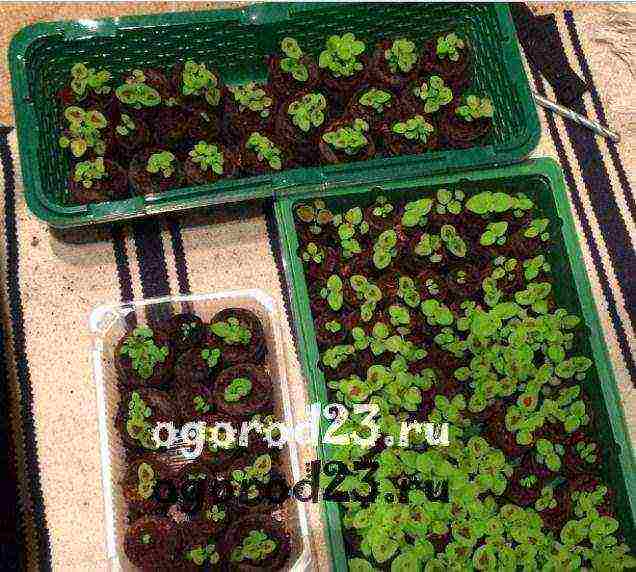
If you buy seeds from a specialty store, keep in mind that the seed of Dutch or English origin has the highest germination rate. According to the general opinion of experienced florists, in order for Coleus to grow quickly and easily, planting with seeds should be superficial. That is, the seed does not need to be actively buried in the soil mixture, but it is enough to scatter it over its surface and press it a little. After that, the seeds must be sprinkled with a very thin layer of sand and sprinkled with clean water at room temperature from a spray bottle. After the planting process, it is best to cover the containers with glass or polyethylene - nothing new (as is the case with the rest of the seeds in such cultivation).
If you decide to grow Coleus using this method, seed reproduction most comfortably occurs in a warm atmosphere. The most optimal temperature for germinating its seeds is + 20 ° C .. + 24 ° C. If you maintain this level constantly, then after about 10-14 days you will see the first sprouts. At this stage, the "greenhouse" can be removed, and the containers can be moved to the lighter east or west windows. Do not forget about direct sunlight - flowers must be protected from them! Young livestock should always be moistened, but in moderation, without excessive waterlogging. Further, having grown a little stronger, the seedlings will feel good at an air temperature of + 16 ° С .. + 19 ° С.Try to provide the young growth with good lighting during the active growth phase so that it does not stretch out and lose its vitality in the future.
Seedlings in peat tablets, photo:
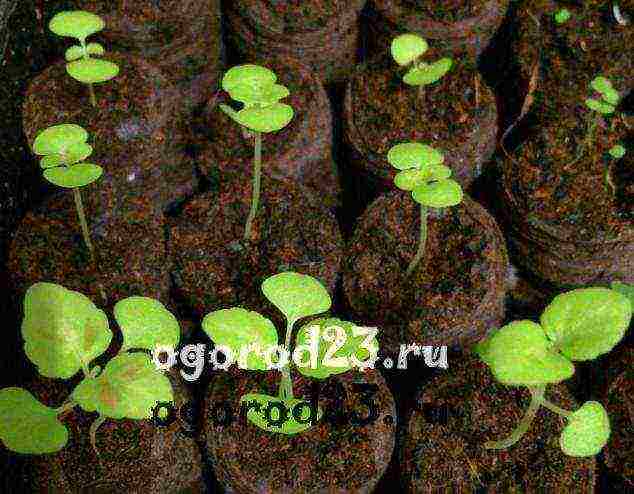
An important point - if you poured the seed into a common tray, then during selection you will have to reject weak and frail plants, and transplant the strongest representatives into separate containers. Don't forget the drainage at the bottom of the pots! That is why it is more convenient for you (less hassle), and it is less traumatic for a flower to sow seeds in special cassettes or peat tablets. Thus, the "operation" of reproduction will be more comfortable, faster, and better for him, the root system will not be disturbed by additional transplantation. And there, in fact, the choice is yours.
When the end of spring / early summer comes, the earth warms up, then the seedlings can be transferred to the flowerbed, the chosen place on the site. Now a new stage has come for you - to protect Coleus from the bright sun and drafts. Care will now be associated with these factors, as well as with watering and protection from pests. We will talk about them a little later. After planting, as it grows, the bushes are formed - pinching the tops of the shoots and lateral processes.
So that the plant subsequently has a spherical shape, the apical bud is removed, as well as the buds at the ends of the lateral branches. Such a simple technique is the answer to a common question - how to pinch Coleus. It should be borne in mind that such manipulation is performed on both small and adult bushes - this not only forms the bush, but also contributes to its splendor. Usually, a neat initial pinching begins when the flower reaches 4-5 cm in height, and the side branches grow up to 5 cm.
↑ to the content ↑ Coleus - propagation by cuttings, care of seedlings and adult plants
This is a very simple and uncomplicated breeding method. To do this, you should choose a healthy, well-developed representative. Next, you need to look after a powerful shoot from him, carefully cut off and put in a container with clean water. The water will have to be periodically changed until the roots appear on the cutting, after which it is transplanted into a pot with a suitable soil mixture. This procedure is best done by late summer / early fall. Thus, you can annually multiply coleus for home breeding, for a flower bed, and simply to share or exchange some new variety with a neighbor in the country.
Cuttings with roots, photo:
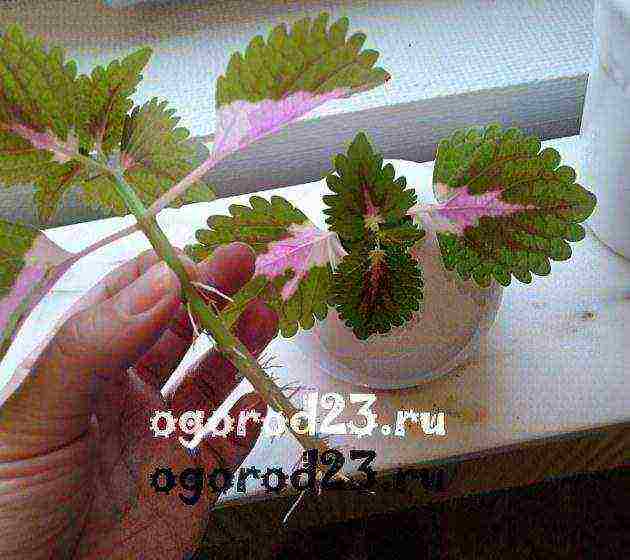
A more detailed description of the process of reproduction of Coleus by cuttings:
- It is advisable to select a shoot without inflorescences and buds at the end. Pruning should be done carefully, just below the leaf assembly. As a result, the length of the cut fragment should be approximately 15 cm.
- From a small bush, you can also take cuttings-shoots, about 6-8 cm long.
- The lower leaves on the handle must be removed, since it will still sink into the soil.
- You can add a root formation stimulant (for example, Kornevin, Humisol, Heteroauxin) to the container with water where you will place the cutting. Prepare the solution strictly according to the recommendations indicated on the package.
- The water should be changed once every 2-3 days, the cutting should be kept in a bright place, but not in direct sunlight.
- Good results are obtained by rooting in vermiculite. Just pour vermiculite into the container, add a little water and insert the cutting into it.
- When roots appear at the shoot, transplant it into a separate pot with drainage holes and drainage itself at the bottom. The damp earth mixture should be suitable - we mentioned it above.
- Sometimes, for greater reliability, it is advised on flower forums to create small greenhouses for cuttings - cover the plant with plastic cups or plastic bags until the young flower gives new leaves. Most often this happens within a month.To do this or not to do this is at your discretion.
- We have already mentioned lighting and shading, but the air temperature in the room where the cuttings are located should be approximately + 20 ° C (not lower).
How to care for Coleus? When foliage and full-fledged roots appear, they should be looked after as expected. The more the flower receives light, the brighter and more colorful its foliage and pattern on it will be. If you have the opportunity to place the bushes in the sun in the morning, and transfer them to the shade by lunchtime, then be sure to use this option. Partial, periodic shade is good for development and growth. If you suddenly notice that your green pet is losing foliage, this is an indicator of a lack of sunlight.
Rooted cuttings:

Do not overmoisten the soil when watering, even on the hottest days - this is fraught with rotting of the root system. Let it be better to water more often, and the amount of moisture is less. During this, make sure that the water only falls on the soil, and not on the stems or foliage - the leaves are very vulnerable. In ideal condition, the soil should always be slightly moistened so that drought does not affect the decorative foliage, and excessive waterlogging does not harm the roots.
If you want your Coleus to be more lush and strong, you can feed it. As mentioned above, this plant does well even without additional fertilizers. However, if you so desire, then during the growing season, once every 10 days, feed it with a special top dressing diluted in water for decorative deciduous representatives. Make sure that at this stage there is no nitrogen in the feeding or there is very little of it, because nitrogen "steals" the bright color of the foliage.
In winter, coleuses are not fertilized at all, however, if you do not have enough light in your room, then once every 30 days you can feed it in winter (with mineral fertilizer).
If you want the flower to grow upward, then remove only the side branches. So it will resemble a small tree, and not a spherical bush (as with the pinching recommended above). To increase "fluffiness" and improve branching, the first flower arrows and tops of the shoots should be removed from the flower, a couple of centimeters each. So the vitality of the plant will be directed to the formation of foliage, and not to flowering. In general, the coleus is trimmed as needed, if desired, it can grow to the state of a lush carpet, which, in principle, also looks quite attractive.
 Lush bushes
Lush bushes
If you like the look of flowering Coleus, its spike-shaped inflorescences themselves, then you can leave a few copies in the most prominent places, and remove the rest. All living things reach out to the sun, and if the flower is kept indoors, then its tilt can be adjusted by turning the pot in the desired direction. In the same way, in order for the flower to look harmonious on the flowerbed, you can set the desired direction with the help of a peg. The shoot is neatly tied to a peg and no less neatly pulled up, directed in the right direction. Bushes that are too heavy, lush and overgrown are also strengthened with such support supports.
How to care for Coleus if cold weather comes? If initially the plant was planned as a perennial, then at the onset of the first night cold snaps, it should be brought into the room. With the onset of "gray" autumn days, gradually accustom him to the shade, so that in winter he feels comfortable in the shade of the room. But try to keep it on the most illuminated side - near the south or southwest windows. Very old bushes cannot be transplanted, it would be much wiser to take cuttings from them and root them, thereby giving life to a new generation.
It is better to do this in the first weeks of the calendar autumn - in September. Protect the plants from drafts, if your house is too dark, then you may need additional lighting with the help of special phytolamps. Watering in winter becomes more moderate.When March comes, Coleus should carry out anti-aging pruning: in adult representatives, old leaves are removed, branches are shortened. This procedure activates the growth of new shoots at the base of the flower. Well, in the spring, when the threat of frost has already passed and warm weather has finally established, the flower can again be transferred to the site.
↑ to content ↑ Diseases and pests of Coleus
Most of all Coleus "love" mealybug, whitefly, aphids, spider mites. To combat them, of course, you should use insecticides ("Imidacloprid", "Confidor Extra", "Zubr", "Aktofit"). If you try to destroy the parasite at the initial stage, then, for example, against the mealybug, sometimes ordinary alcohol helps, with which a piece of cotton wool is moistened and the places of its settlement are wiped. Another surprisingly simple method, however, helps to get rid of hairy lice (another name for mealybug). The tincture of the peel of lemons and oranges is poured with boiling water (50 g per 1 liter of water), infused for a day, after which the flower should be abundantly sprayed with this "medicine" using a spray bottle.
Laundry or tar soap, previously grated and dissolved in water (1: 6), can help against whitefly. Such a solution, or rather, its thick foam, which is convenient to beat with a foam rubber sponge, is applied to the places where the larvae accumulate with the same sponge. Or, you can irrigate all affected coleus with this mixture and a garden spray. The soil should also be carefully sprayed with soapy water.
Soap solution also helps against aphids, only in this case it is enough to take 300 g of brown laundry soap, grind and dissolve in 10 liters of water. Tar soap for 10 liters of water will require much less - 100-150 g. To enhance the striking effect, you can add wood ash to the resulting composition, and if you also hold the bucket with this brew on the fire for about 30 minutes, the product will become many times more powerful and more efficient. In general, ash itself is a very good remedy against aphids; it is sprinkled on the ground around and on the leaves affected by pests. With its help, many diseases of the Coleus are stopped.
The above-described soap solution and alcohol solution helps against spider mites. For this, ammonia is taken (30 ml per 10 liters of water) and abundant irrigation of the affected plants is carried out. Ordinary garlic can also help you: 30 or 50 g of garlic need to be chopped, pour 10 liters of boiling water, leave to infuse for 24 hours. With such a broth, irrigation can also be carried out, and if you add finely grated soap to the composition, then the spider mite simply has nowhere to go.
By the way, the above methods are good only in the initial stages of the disease; in more serious cases, the help of the chemicals mentioned above will be required. If you notice a fungus on the leaves, then immediately remove all affected fragments, and thoroughly disinfect the garden tools themselves. Modern antifungal sprays sold in flower shops are great for treating fungi and harmful mold.
Do not forget that excessive watering and lack of sunlight can also provoke diseases such as root rot and loss of foliage. Just follow the rules of care, periodically inspect the bushes and at the first suspicion of disease or the presence of parasites, immediately take action.
These plants themselves, at times, have a unique color, such as the Black Star or Scarlet Heart varieties. However, in combination with other garden dwellers, they also look very harmonious. Variegated coleus looks very decorative and beneficial with sage, hornwort, different types of ferns, lobelias, petunias, tagetes and even roses.
Coleus on a flower bed and lawn, photo:




It all depends on your imagination and perception of shades, the main thing is that you like it.One more little tip in the end: if the cold has already passed, and you did not have time to sow seedlings in advance or acquire cuttings, sow the seeds directly into the ground - they will rise, definitely. You can also sow seeds of other flowers nearby, using the same method, you get something like a "spontaneous" flower bed, but the bright colors of the flowers that have emerged will still delight the eyes.
 Be sure to plant Coleus on your site. Planting and caring for this plant in the open field will not take much time and effort from you, and aesthetic pleasure for the whole season will be provided!
Be sure to plant Coleus on your site. Planting and caring for this plant in the open field will not take much time and effort from you, and aesthetic pleasure for the whole season will be provided!
↑ to content ↑ Coleus varieties, photo  Dark Star variety (Black Star)
Dark Star variety (Black Star) Kingswood Torch variety
Kingswood Torch variety Variety Scarlet Heart (Red Heard)
Variety Scarlet Heart (Red Heard)

Variety Sea Weed, sometimes called Salvador Dali Sedona variety
Sedona variety Saturn grade
Saturn grade Fishnet Stocking Variety
Fishnet Stocking Variety
